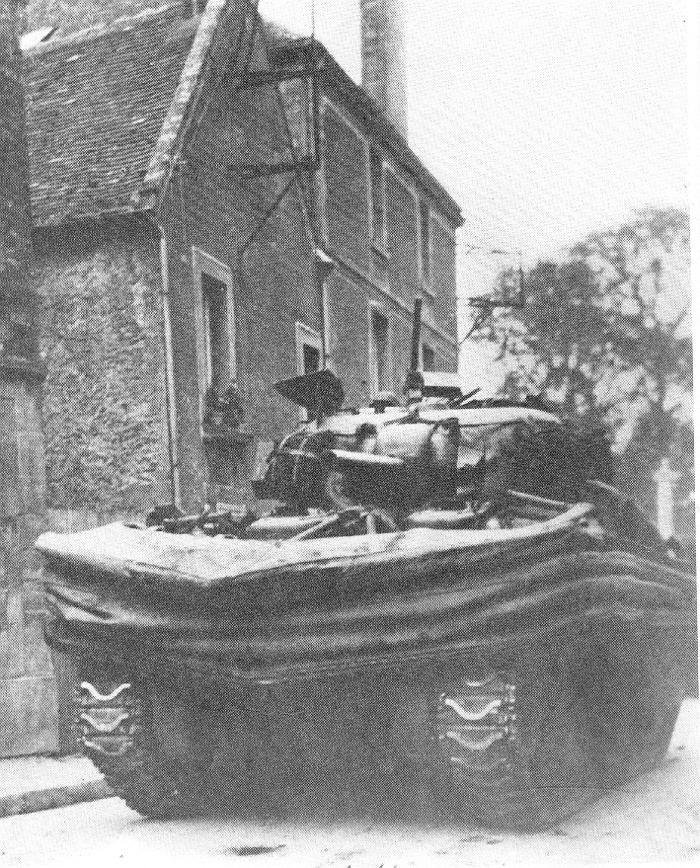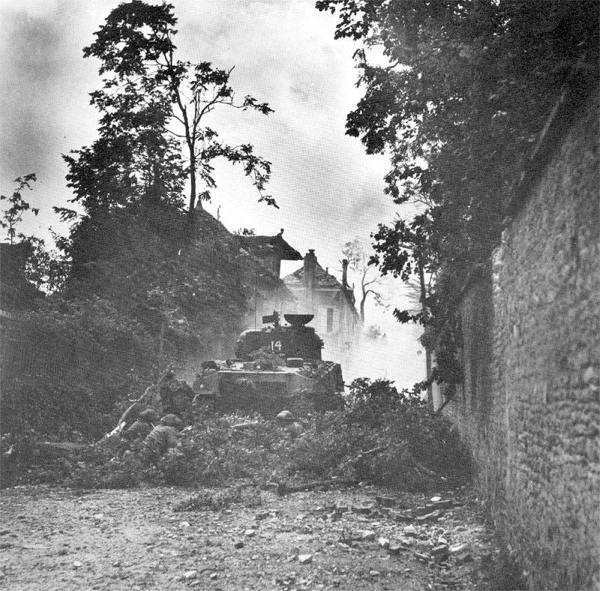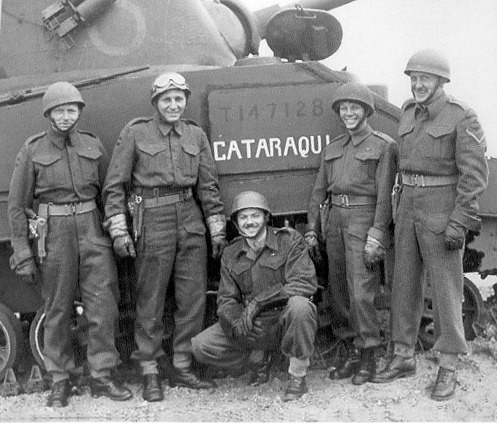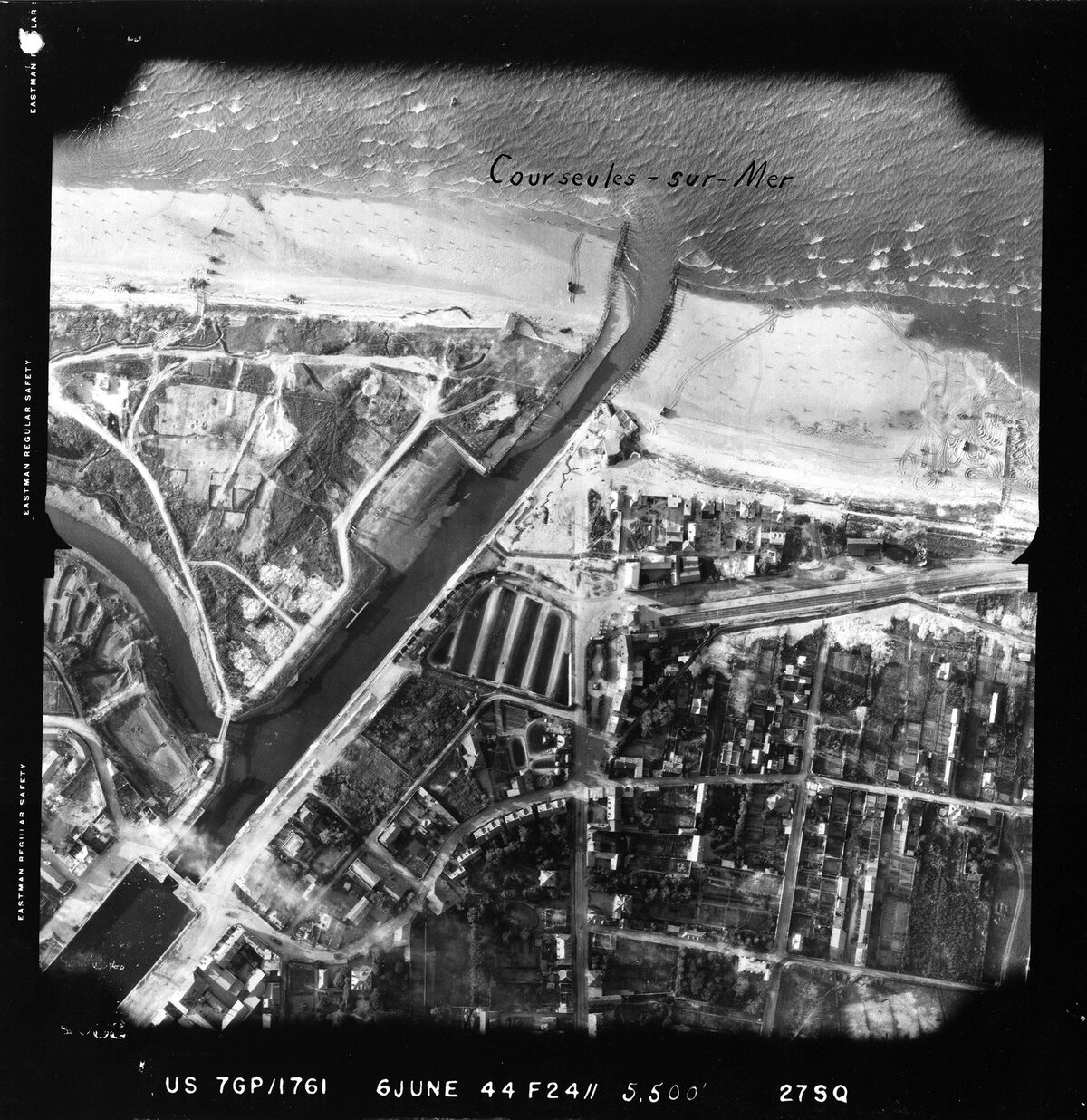

The 1st Hussars Regiment was from London, Ontario. The 1st Hussars were equipped with DD (Duplex Drive) tanks. The tankers of the Hussars supported the Regina Rifles at Courseulles-sur-Mer, the Winnipeg Rifles at Graye-sur-Mer and the Canadian Scottish on the right.
'B' squadron supporting the Reginas, landed at Courseulles at 0755 hours with 14 out of the 19 tanks remaining. The DD tanks engaged the German guns from a distance of 200 yards. An 88mm beside the harbour exit and a 50 mm behind it fired continuously until their protective shields were pierced by shells. A 75 mm on the right flank fired 200 rounds before it was knocked out. No tanks were lost in the spirited duel. When the Regina Rifles landed, they fought their way into Courseulles-sur-Mer, and once beyond the town the tank squadrons reunited with their affiliated infantry battalions and worked their way inland against machine-gun nests and entrenched infantry.
Seven 'A' squadron tanks landed a few minutes after the Winnipeg Rifles, on the beach west of Courseulles-sur-Mer where the German defences included three blockhouses and more than thirteen concrete gun emplacements. The tanks fired on the 50 mm anti-tank gun emplacements. Five more tanks were landed by a LCT that earlier had had problems with its ramp. As soon as the anti-tank guns on the beach had been destroyed, the DD tanks began to cruise up and down the beach engaging the machine gun nests permitting the infantry to sweep over the dunes to begin their push inland. There were delays in creating beach exits, but the engineers were able to clear a path and complete a causeway at 0920 hours and 'A' squadron began to move toward their first objective, Graye-sur-Mer.

The Sherman DD tank commanded by Leo Gariepy rumbles through the streets of Courseulles in the first moments after the invasion.
The regimental history gives the following description: "D-Day Operation Overlord. At 0730 hours 6th June, 1944, the 6th Canadian Armoured Regiment (1st Hussars) in support of the 7th Canadian Infantry Brigade of the 3rd Canadian Division assaulted and overpowered the Hun's beach defences between Courseulles-sur-Mer and Bernières-sur-Mer and after wiping out enemy resistance moved inland…. During the rest of day the Shermans scurried here and there as the Winnipeg Rifles pressed inland and gave fire support to neutralize enemy positions. Whenever the 'Pegs' were pinned down the tanks played a role in helping the infantry to clear each successive town as the advance moved on."
'B' squadron, reduced to half-strength and numbering only nine tanks, was severely hit when hurrying to the aid of infantry attacking Pierrepont. Five tanks were lost to fire from a well handled 88mm gun. Sgt Leo Gariepy: "I saw Lieutenant McLeod's tank burst high in flame. The troop corporal's tank suffered the same fate, and I saw several other tanks knocked out." Gariepy saw the muzzle on an 88mm gun rising from a hidden emplacement 30 yards ahead, the barrel pointing directly at him. "I gave rapid evasive orders to my driver and told my gunner to blast him. He fired two rounds; the second scoring a direct hit. I moved up to the gun emplacement and shot all the crew of 14 cowering in the trench."

Infantry take cover behind Sherman tank during street fighting.
After helping the Winnipeg Rifles through Creully, one troop of 'C' Squadron commanded by Lt. W.F. McCormick pushed on towards the objective and made it all the way to the north edge of Secqueville-en-Bessin without encountering any opposition. The troop had probably got closer to the final objective than any other element of the Allies' seaborne assault forces, but finding themselves isolated without infantry or anti-tank support they retraced their steps and rejoined the regiment.

Lt McCormic and tank crew.
The regimental history: "In view of the losses in DD tanks due to the unsuitable weather, the First Hussars ended D-Day with a considerably smaller number of tanks than was desirable for their first night in Europe. In addition, the infantry continually had to anticipate Jerry counter-attacking heavily with armour in an attempt to kick them back on the beaches. However, the eventual appearance of the tanks with their capability of needling out the MG posts raised the morale of the infantry, so that by nightfall Harry Foster's 7th Brigade was firmly astride the line running through Fontaine-Henri, Pierrepont and St. Gabriel."
After dark the First Hussars tanks rallied in a harbour on high ground
south-west of Pierrepont.

Sherman DD Tanks of the First Hussars land at Mike Red sector (left of the harbour) and Nan Green sector (right of the harbour).
On each side of the harbour a single tank can be seen to have driven right up to a German bunker. On the right of the photo, another Sherman has maneuvered extensively
(see the tracks in the sand) as it engages the German defenders in Courseulles. At least one Sherman can still be seen in the water at the top of the photo.
